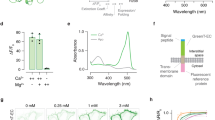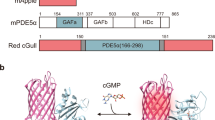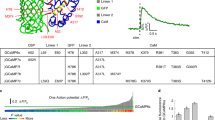Abstract
Visualization of signal transduction in live primary cilia constitutes a technical challenge owing to the organelle's submicrometer dimensions and close proximity to the cell body. Using a genetically encoded calcium indicator targeted to primary cilia, we visualized calcium signaling in cilia of mouse fibroblasts and kidney cells upon chemical or mechanical stimulation with high specificity, high sensitivity and wide dynamic range.
This is a preview of subscription content, access via your institution
Access options
Subscribe to this journal
Receive 12 print issues and online access
$259.00 per year
only $21.58 per issue
Buy this article
- Purchase on Springer Link
- Instant access to full article PDF
Prices may be subject to local taxes which are calculated during checkout



Similar content being viewed by others
Accession codes
References
Christensen, S., Clement, C., Satir, P. & Pedersen, L. J. Pathol. 226, 172–184 (2012).
Singla, V. & Reiter, J.F. Science 313, 629–633 (2006).
Berbari, N., Johnson, A., Lewis, J., Askwith, C. & Mykytyn, K. Mol. Biol. Cell 19, 1540–1547 (2008).
Praetorius, H.A. & Spring, K.R. J. Membr. Biol 184, 71–79 (2001).
Whitfield, J.F. Cell. Signal. 20, 1019–1024 (2008).
Köttgen, M. et al. J. Cell Biol. 182, 437–447 (2008).
Nauli, S.M. et al. Nat. Genet. 33, 129–137 (2003).
Belgacem, Y.H. & Borodinsky, L.N. Proc. Natl. Acad. Sci. USA 108, 4482–4487 (2011).
Bai, C.-X. et al. EMBO Rep. 9, 472–479 (2008).
Kleene, N. & Kleene, S. Cilia 1, 17 (2012).
Nachury, M.V., Seeley, E.S. & Jin, H. Annu. Rev. Cell Dev. Biol. 26, 59–87 (2010).
Mank, M. et al. Nat. Methods 5, 805–811 (2008).
Horikawa, K. et al. Nat. Methods 7, 729–732 (2010).
Akerboom, J. et al. J. Neurosci. 32, 13819–13840 (2012).
Zhao, Y. et al. Science 333, 1888–1891 (2011).
Mank, M. & Griesbeck, O. Chem. Rev. 108, 1550–1564 (2008).
Hori, Y. et al. Biochem. Biophys. Res. Commun. 373, 119–124 (2008).
Svendsen, S. et al. BMC Cell Biol. 9, 17 (2008).
Berbari, N.F. et al. Mol. Biol. Cell 19, 1540–1547 (2008).
Follit, J.A. et al. J. Cell Biol. 188, 21–28 (2010).
Lin, Y.C. et al. Nat. Chem. Biol. 9, 437–443 (2013).
Honda, A. et al. J. Biol. Chem. 285, 31362–31369 (2010).
Narita, K. et al. Traffic 11, 287–301 (2010).
Acknowledgements
We thank A. Seki and T. Meyer (Stanford University) for the 5HT6 construct, M. Fivaz (National University of Singapore) for the Lyn-YFP construct, A. Miyawaki (RIKEN) for the YC3.60 construct, L. Looger (Janelia Farm) for the GCaMP5G construct, G. Pazour (University of Massachusetts) for the GFP-CTS20 and GFP-CTS68 constructs, O. Griesbeck (Max Planck Institute) for the TNXXL construct, R. Reed (Johns Hopkins University) for mIMCD3 cells, and Y. Okubo, K. Kanemaru and H. Ishikawa for helpful comments on the manuscript. This study was supported in part by the US National Institutes of Health (NIH) (GM092930, DK065655 and DK090868 pilot funds provided by the Baltimore Polycystic Kidney Disease Research and Clinical Core Center) to T.I., and other grants to S.C., K.N., S.T., K.K. and T.K. from the Ministry of Education, Culture, Sports, Science and Technology of Japan and the Japan Society for the Promotion of Science. S.C.P. is supported by the Agency for Science, Technology and Research in Singapore.
Author information
Authors and Affiliations
Contributions
S.S., S.C.P., R.D., P.N.K. and T.I. generated constructs. K.K. developed the IA sequence under the supervision of T.K. The immunohistochemistry was performed by S.C., and K.N. and S.T. took the transmission electron microscopy images. S.S., S.C.P., R.D. and P.N.K. carried out cell biology experiments and microscopy under the supervision of T.I. S.C.P., S.S. and T.I. wrote the manuscript.
Corresponding author
Ethics declarations
Competing interests
The authors declare no competing financial interests.
Supplementary information
Supplementary Text and Figures
Supplementary Figures 1–14 and Supplementary Table 1 (PDF 2286 kb)
5HT6–G-GECO1.0 can detect an increase in ciliary Ca2+ in NIH-3T3 cells.
The addition of 1 μM ionomycin causes a dramatic increase in fluorescence of 5HT6-G-GECO1.0 in cilia of NIH-3T3 cells. Scale bar is 5 μm. (AVI 10814 kb)
5HT6–G-GECO1.0 can detect ciliary [Ca2+] dynamics in response to ATP stimulation.
The addition of 10 μM ATP induces an increase in both cytosolic and ciliary Ca2+ in NIH-3T3 cells co-transfected with 5HT6-G-GECO1.0 and R-GECO1. The left image is cytosolic R-GECO1. The middle image is of the corresponding cell's cilia expressing 5HT6-G-GECO1.0. The right image is a merged image. The increase in cytosolic Ca2+ can be seen to precede the increase in ciliary Ca2+. Additionally, oscillations in cytosolic and ciliary Ca2+ can be observed in some cells. Scale bar is 10 μm. Video captured at 0.63 Hz. (AVI 116735 kb)
Ca2+ enters the base of the cilia and propagates to the tip after ATP stimulation.
Ca2+ can be seen entering the base of a cilia and traveling to the tip after the addition of 10 μM ATP in NIH-3T3 cells transfected with 5HT6-G-GECO1.0. Scale bar is 5 μm. Video was captured at 1.5 Hz. (AVI 27537 kb)
Dynamic Ca2+ signals detected in primary cilium bent with mechanical flow stimulation.
An upright-positioned primary cilium was subjected with laminar flow corresponding to 1dyne/cm2 shear stress approximately 2 minutes after the start of imaging. Flow was continued for 7.5 minutes before cilium was further imaged for another 4 minutes. Time-lapse imaging was performed at 15-second intervals. Z-projection of xy-planes are presented in this movie. The scale bar corresponds to 5 μm. The scale for the pseudo-colored GFP/ mCherry images has been included in Supplementary Figure 13c. (AVI 143475 kb)
Rights and permissions
About this article
Cite this article
Su, S., Phua, S., DeRose, R. et al. Genetically encoded calcium indicator illuminates calcium dynamics in primary cilia. Nat Methods 10, 1105–1107 (2013). https://doi.org/10.1038/nmeth.2647
Received:
Accepted:
Published:
Issue Date:
DOI: https://doi.org/10.1038/nmeth.2647
This article is cited by
-
Compression enhances invasive phenotype and matrix degradation of breast cancer cells via Piezo1 activation
BMC Molecular and Cell Biology (2022)
-
A change of heart: new roles for cilia in cardiac development and disease
Nature Reviews Cardiology (2022)
-
Control of the Hedgehog pathway by compartmentalized PKA in the primary cilium
Science China Life Sciences (2022)
-
Growth and site-specific organization of micron-scale biomolecular devices on living mammalian cells
Nature Communications (2021)
-
Structure- and mechanism-guided design of single fluorescent protein-based biosensors
Nature Chemical Biology (2021)



